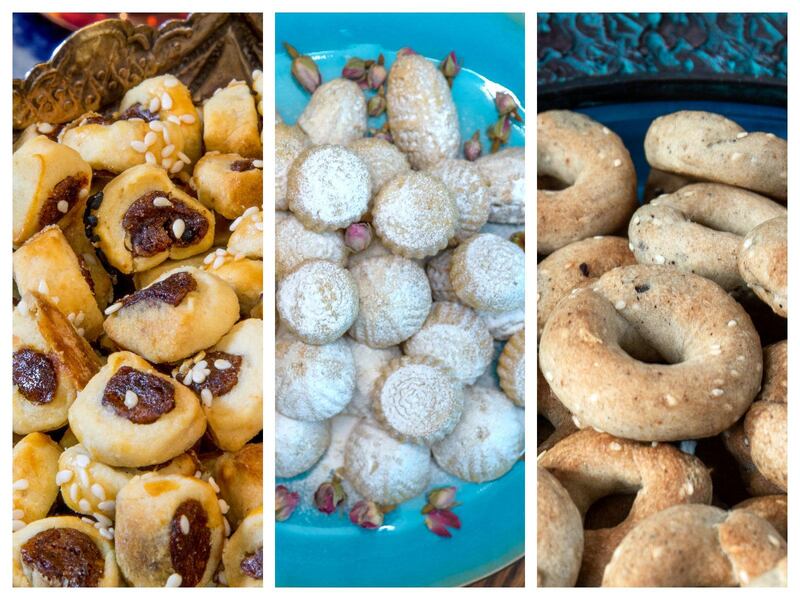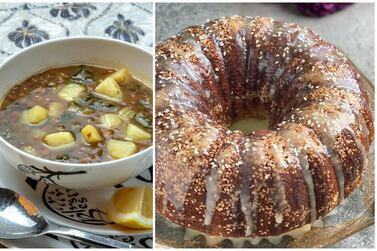Thursday, marks the end of Ramadan. The holy month of fasting culminates in the three-day festival of Eid Al Fitr. It is a time of charity, and a celebration of endurance and strength, evermore relevant in the midst of a global pandemic. It is also a time to see family and friends, exchange gifts and savour the sweet delicacies of Eid, be it Egyptian kahk, Iraqi kleicha or ma'amoul in Syria, Lebanon, Jordan and Palestine.
When I was invited to write about popular sweets consumed around Eid, I was reminded of Proust’s madeleine. More than 100 years ago, the famous French author Marcel Proust imbued the humble madeleine with the potential to evoke powerful memories.
In his book A la Recherche du Temps Perdu (In Search of Lost Time), the narrator recalls an episode after tasting a madeleine dipped in lime tea. "No sooner had the warm liquid mixed with the crumbs touched my palate than a shudder ran through me and I stopped, intent upon the extraordinary thing that was happening to me." Proust realised that the act of eating a madeleine as an adult resurrected the context of his childhood. The madeleine became a sensory cue that involuntarily triggered a memory and served as a symbol of the past.
Eid cookies are my madeleine.

I grew up in Kuwait, to an Egyptian father and Syrian-Lebanese mother, among a large Palestinian diaspora and a multinational population, and Ramadan and Eid Al Fitr were times of culinary delight.
On the 29th day of Ramadan, we anxiously awaited the sighting of the new Moon, quivering with the suspense of not knowing if we had one more day to fast and how late we could stay up. Once the announcement was made on the radio or TV (now more likely a text message), we readied our new garbs for the next day’s festivities.
One Eid, out of excitement, I wore my new clothes in the evening and slept in them so as to be fully ready the next day, only to wake up and realise they were all wrinkled.
Eid celebrations started with the collective prayer (salat al Eid) followed by preparations for the family lunch around al ma’eda al mustadeera (the round table), as my father referred to it. His speciality was Egyptian fatteh, which he prepared every Eid.
A busy working woman, my mother has considerable baking skills, which lay dormant for most of the year until the month of Ramadan, when she would fill the round table with our favourite desserts. She would often try recipes that were exchanged in the teachers' lounge of the school she worked at, especially in preparation for Eid – Palestinian ka'ak, Lebanese ma'moul, Egyptian kahk and Syrian ghuraybe and barazek. Her kunafa, basbousa and qatayef were irresistible, scented with orange blossom and swimming in a puddle of atir (syrup). It was during Eid that we truly harvested the culinary delights of our dual heritage – my mother made both the Levantine ma'moul and the Egyptian kahk to please my father.
The preparation of the Eid sweets began a few days in advance. The ma'moul dough, a combination of semolina and flour, is kneaded with butter and ghee, and left to soak overnight. The following day, the mastic, a sun-dried resin, and mahlab, a spice made from cherry pits, are added to the dough along with the spices of fennel and aniseed. Then the three types of filling are prepared: dates, pistachio and walnuts infused with orange blossom water. Each filling has its own mould to differentiate it visually. The nut-filled ones are covered in powdered sugar, while the dates are not, as they are sweet enough.
The stuffing and decorating of the ma’maoul is labour-intensive and involved roping in various members of the family in my home. My mother would make them in large batches and share them with friends, just as she received them from visitors.
Preparing the Egyptian version, kahk, proved more of a challenge for my mother, as she experimented with different recipes handwritten in her notebook. In addition to the plain and nut fillings, Egyptians have a version stuffed with agameya (a honey-walnut concoction) and loukoumi (Turkish delight).
Achieving the right balance between the ingredients to get a cookie with a soft filling that melts in your mouth, yet holds its shape without crumbling is key to a great kahk. This was a topic of debate at the round table, when my father would sample the kahk my mother had made, as well as the ones sent fresh from Egypt or made at local sweets shops.
It seemed that each Eid my father – who left his home city, Cairo, at a young age – was in search for the perfect kahk, probably his Proustian madeleine.
Visiting friends and family was an important ritual during the Eid, whether we went out to meet them or hosted gatherings in our home, often in open-house style, with people coming and going throughout the day – all the more reason to make sure we had plenty of sweets to go around, served with coffee or tea.
Any house we went to during Eid always had ma'moul, kahk or klaiche – the Eid cookie. Each family had a slightly different way of making the Eid cookie, so it was always fun to compare the variations and call out our favourites in the car on the way home.
This Eid, the first without my mother, I honour her memory by sharing a collection of recipes for Eid sweets from my friends, as she once did with her friends, carefully recording them in notebooks I will treasure forever.
Ma’amoul three ways
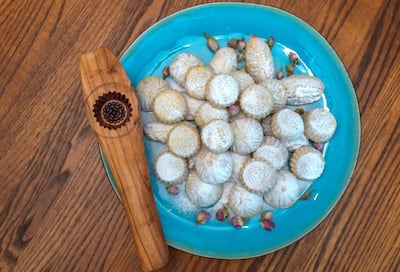
Recipe contributor Nihaya Mansour says: "No Eid celebration is complete without ma'amoul. Following a month of fasting and in the few days leading up to Eid Al Fitr, most homes are busy preparing ma'amoul. These buttery semolina cookies are filled with either dates, walnuts or pistachio. The aromas wafting through the house are irresitable and always bring back childhood memories of my mum baking them with our neighbours."
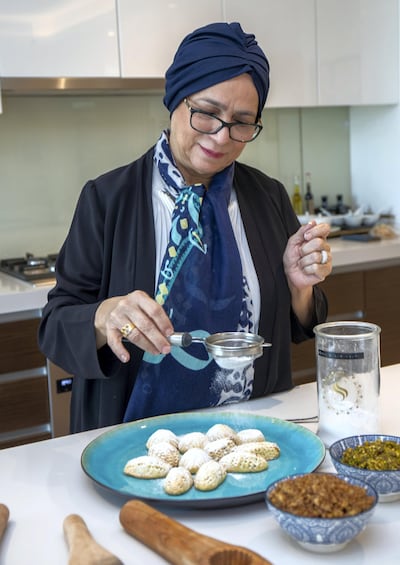
About 4 dozen
Ingredients for the dough
500g fine semolina
250g unsalted butter, melted and kept at room temperature
3 tbsp milk powder
3 tbsp powder sugar
½ tsp mastic, ground
½ teaspoon mahlab, ground
1 tsp kaak spices
1/3 cup orange blossom water
¼ cup rose water
Ingredients for the date filling
500g pitted date paste
½ tsp cinnamon
1 tbs ghee
Ingredients for the pistachio filling
200g pistachio, coarsely ground
2 tbsp orange blossom water
2 tbsp sugar syrup
1 tbsp ghee
Ingredients for the walnut filling
250g ground walnuts, coarsely ground
1 tbsp cinnamon powder
2 tbsp sugar syrup
1 tbsp ghee
Method for the dough
Place the semolina in a large bowl and add the melted butter. Rub the butter into the semolina using your fingertips, until the semolina completely absorbs the butter. The texture should resemble moist sand.
Cover the bowl with cling film and set aside overnight to soak. The mixture can be prepared up to 48 hours ahead of time and longer if placed in the fridge.
When ready to assemble the ma'amoul, add the milk powder, sugar, mastic, mahlab and kaak spices to the semolina mixture, mixing gently as you go.
Drizzle the orange blossom and rose water, and mix by rubbing between your fingertips. The dough should be soft and not crack when squeezed in the palm of your hand. If cracking occurs, splash the mixture with a small amount of water and mix. Do not overwork the dough.
Method for the date filling
Add all the ingredients together and knead with your hands until soft and workable enough to roll into small balls. Wet the palm of your hands with a bit of olive oil to avoid the dates from sticking. Form into 2 centimetre balls.
Method for the pistachio filling
Place all the ingredients in a bowl and mix. Adjust the sweetness by adding more sugar syrup, to taste. Similarly adjust the flavours by adding the orange blossom water and cinnamon.
Method for the walnut filling
Place all the ingredients in a bowl and mix. Adjust the sweetness by adding more sugar syrup, to taste. Similarly adjust the flavours by adding the orange blossom water and cinnamon.
Assembly
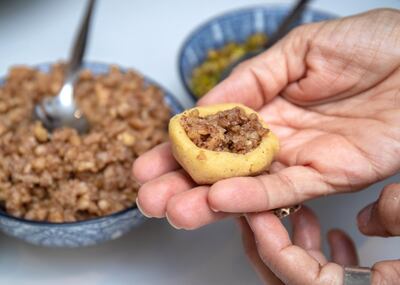
Pinch a walnut-size piece of dough and roll into a ball.
For the date filling, flatten the dough ball, place a date ball inside and seal the dough around the paste making sure the filling is completely enclosed by the dough. Shape into a ball.
Place the dough in your chosen mould, press down firmly, but do not overdo it, so it does not stick. Turn the mould over and on to a clean kitchen towel, tap the mould and tip the shaped ma’amoul dough out.
For the pistachio and walnut fillings, press down into the ball-shaped dough with your thumb to form a cup shape. Add enough nut filling to be able to cover it with the same piece of dough, rolling and smoothing it out. Use a different shape mould to the date ma’amoul mould (best to have one for each filling). Use the same method as above to create the final shape.
Bake in the middle rack of an oven preheated to 180°C until the edges of the ma’amoul are golden brown (about 10 minutes).
Allow to cool and dust the nut-filled ma’amoul only with icing sugar. The date ma’moul is sweet enough.
Kleicha tamur (Iraqi date cookies)
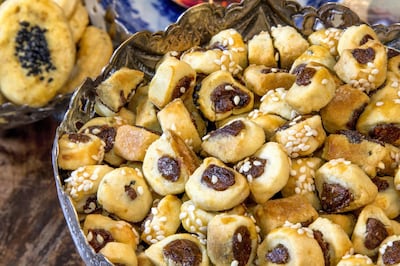
Recipe contributor Reem Orfali says: "Kleicha is considered the national cookie of Iraq. These can be filled with dates or walnuts, mixed with cheese or left plain. Plain kleicha are called khufaifiya and are usually made with leftover cookie dough. The most popular are the ones filled with dates – kleicha tamur – from the rich palm groves of Iraq.
"Every Iraqi family makes their kleicha in different shapes and sizes. Following my mother's example, I prepare mine in a 'micro' version, which requires patience. My daughter, with her delicate touch, completes the cookies by dotting them with habbat baraka (nigella seeds), meaning seeds of blessings. Traditionally we make this kleicha for Eid, and refer to it as kleichat al Eid, but I also make them year round to share with family and friends."
Makes 5 to 6 dozen
Ingredients for the filling
450g dates, pitted
28g butter
½ tsp cardamom
¼ tsp cinnamon
Ingredients for the dough
450g all-purpose flour or combination with whole wheat
1 tbsp baking powder
⅛ tsp salt
1 tsp nigella seeds
225g butter or vegetable ghee
180ml low-fat milk, or more as needed
1 egg, lightly beaten
Sesame or nigella seeds, to garnish
Method for the filling
Place the pitted dates and butter in a skillet and sprinkle with the cardamom and cinnamon. Stir the mixture over medium heat until it comes together like a paste. Set it aside to cool.
Flatten a handful of date paste and roll it to make a long cord-like shape that is about half centimetre thick and about 20cm long. Continue for all the date paste. The date cords do not need to be perfectly smooth, as the dough will be rolled around them.
Method for the dough
Preheat the oven to 180°C. Mix the flour, baking powder, salt, and nigella seeds in a large bowl or food processor. Cut or pulse the butter or ghee into the flour until it resembles coarse crumbs. Gradually add the milk and knead until the dough is smooth and well combined. Cover and let it rest for 30 minutes.
Working on a floured surface, roll a third of the dough into a half cm thick rectangle. Place a date cord along the long edge of the dough. Using a non-serrated knife, lift the dough over the date cord. Roll the dough around the cord one and a half times. Cut along the side of the dough-date roll to detach it from the rest of the dough. Using both hands, roll the dough-date roll on the work surface to firmly attach the filling to the dough. (For a smaller cookie, continue to roll the dough-date roll by hand to double its length and make it thinner.)
Cut into one cm pieces and transfer to a greased and floured baking tray. Repeat for the remaining dough and date paste.
Brush the tops of the cookies with the egg. Sprinkle with nigella or sesame seeds. Bake for 10 minutes or until golden, ensuring not to over-bake, as the cookies will harden. Transfer them to a baking tray and let the cookies cool. They can be stored in an airtight container for up to 10 days or frozen in plastic bags.
Ka’ak asawer (bracelet cookies)
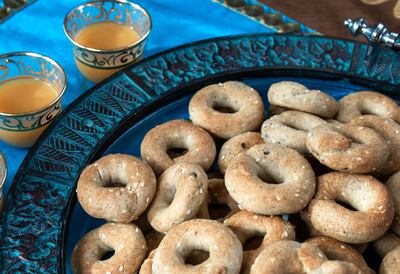
Recipe contributor May Al Moghrabi says: “Date cookies or ka’ak asawer are definitely a Palestinian staple. Traditionally, they are made in the villages, where semolina is less commonly used. As a child, I used to look forward to Eid mornings and the heavenly aroma of freshly baked ka’ak asawer. Now I make them year-round for family and friends to enjoy with a morning coffee or afternoon tea. The key to this recipe is to heat the oil and ghee before adding it to the dry ingredients.”
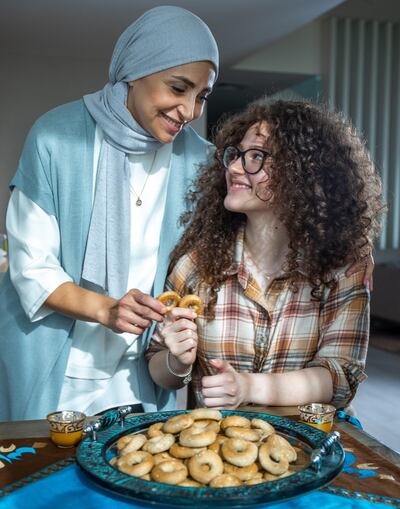
Makes 40 to 45 cookies
Ingredients for the dough
500g 00 flour
1 tbsp fennel powder
½ tsp baking powder
1 tbsp anise powder
½ tsp mahlab
3 tbsp roasted sesame seeds
1 tbsp powder sugar
½ cup ghee
½ cup olive oil
¼ tsp instant yeast
1 tsp granulated sugar
Ingredients for the date filling
750g date paste
1 tbsp ghee, melted
½ tbsp fennel powder
½ tbsp anise powder
½ tbsp cinnamon powder
Method
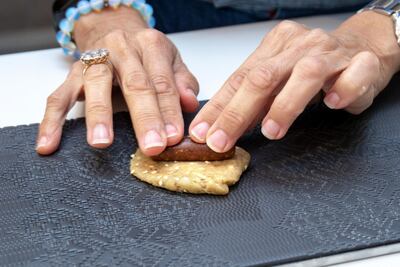
In a large bowl, mix the flour, fennel, baking powder, anise, mahlab, sesame seeds and powder sugar.
Heat the ghee and oil in a saucepan on high heat. To check if it is ready, drop a piece of pita bread; if it turns golden, it’s ready. Pour the oil-ghee mixture over the dry ingredients and stir with a wooden spoon to combine.
Knead the dough by hand, rubbing between the palms until it is the texture of wet sand. This process is called to “bis” the dough in Arabic.
In a small bowl, place the sugar and yeast. Add half a cup of tepid water and stir. Allow the yeast to bubble. Gradually pour the yeast water into the flour mixture and knead by hand. Add another quarter cup of water and continue to knead until the dough is smooth and shiny, about five to eight minutes. Let the dough rest, covered, for an hour.
Meanwhile, prepare the date filling. Mix the date paste, ghee, fennel, anise and cinnamon until well combined. Take a small amount of the paste and roll into a log that is about four cm long and one cm thick. Repeat for the remaining paste. Set aside.
To make the cookie, pinch a small piece of dough. Flatten it by hand into an oval shape. Place a date log in the centre of the dough. Fold the dough over the date filling to get the shape of a cylinder. Roll the cylinder on the counter with your palm to evenly extend it so it is 10cm to 12cm long. Trim the ends and bring them together to form a circle. Pinch the ends to seal the circle. Repeat until all the dough is rolled into cookies.
Preheat the oven to 180°C. Bake the cookies for 20 to 25 minutes or until the bottoms are golden. Allow to cool before serving. These cookies can be stored in an air tight container for up to two weeks.
These recipes have been curated by Hanan Sayed Worrell, author of Table Tales: The Global Nomad Cuisine of Abu Dhabi. The Table Tales concept celebrates the people and stories that give flavour to recipes of the Middle East
